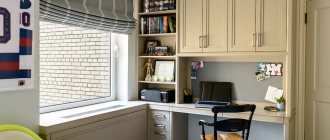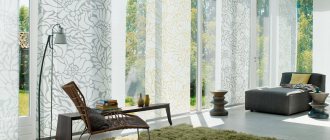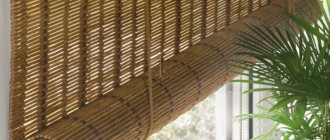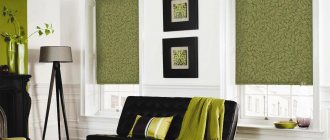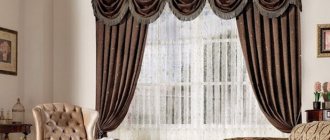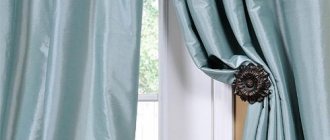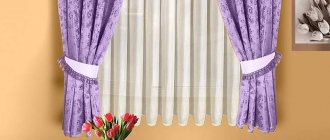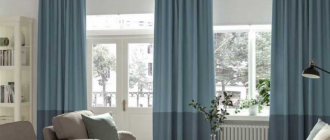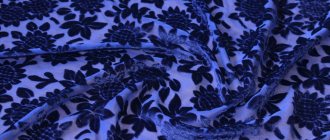There is hardly anything more conservative than white tulle. It was actively used both in the Middle Ages and at the beginning of the 20th century. And modern complex curtain designs are appropriately complemented by this light fabric.
White tulle will look equally beautiful in any room, regardless of its design and purpose.
Interior design features
There are a certain number of features:
- Linen has the ability to repel dirt, so curtains made from this fabric are perfect for decorating a kitchen.
- Linen curtains do not need lush drapery, as the texture of the material looks beautiful on its own. Therefore, you should not overload them with additional elements.
- Thick linen fabrics are more suitable for a bedroom or living room, where they will look expensive and stylish.
- The color of the curtains is selected in accordance with the main appearance and decor of the room.
Main characteristics of linen fabric
Eco-friendliness and practicality are just some of the important qualities. Linen curtains have an excellent appearance and fit into any type of interior. This fabric is produced fully or partially bleached, or no brighteners are used in production.
Often, companies that produce this material apply an interesting pattern to the fabric, or dye linen threads in different tones to ultimately get a checkered pattern, jacquard, stripes, or diamonds.
Types of fabrics
Depending on the purpose, linen fabrics are classified into the following types:
- Linen. They are used for sewing underwear and bedding. As a rule, the material is bleached.
- Towels. The fabrics are used for sewing towels.
- Dining rooms. Bleached or plain-dyed fabrics from which tablecloths and table napkins are sewn.
- Clothes. This material can be either plain or with a pattern on the surface. The fabric is used for making clothes. Things can be used both in summer and winter. In addition to feeling cool in hot weather, linen provides great warmth.
- Applied. Used for making small decorations (mainly for clothing).
- Decorative. This type of fabric is used for interior decoration. Decorative fabric is mainly used to make curtains, upholstery or pillowcases for decorative pillows.
There is also a classification according to weaving types:
- Twill.
- Linen.
- Large patterned.
- Finely patterned.
- Openwork.
- Satin.
Depending on the density of linen fabric and the method of weaving the threads, the material is divided into subtypes:
- Canvas. Used to make painting canvases.
- Tarpaulin and canvas. Used for sewing tents, raincoats and waterproof specialties. clothes. The material is woven from thick fibers and impregnated with special water-repellent compounds.
- Sackcloth. Bags are made from this coarse type of linen fabric, but the material is often used in decoration due to its special texture.
- Batiste. Lightweight material is intended for sewing clothes and sophisticated lingerie.
- Damask. A thick type of linen fabric that is used for sewing curtains and furniture upholstery.
- Crinoline. Thick lining fabric.
In addition to the above types, there are also kolomyanka, fine linen, ravenduc, matting and teak. All except the last one are mainly used for sewing clothes (from summer dresses to men's suits).
Visher flax is also found. This is a combined natural-synthetic material. It is almost 80% polyester, with the remainder being linen and spandex.
Types of linen
It differs in the type of weave of threads. Of all varieties of such fabrics, linen curtains are sewn. This is what manufacturers do:
- Twill weaving.
- Jacquard.
- Linen.
- With large patterns.
- With small ornaments.
- With openwork motifs.
Many foreign manufacturers produce quite expensive linen fabrics, which are used for sewing curtains, clothing, textiles, and creating exquisite accessories.
Domestic companies produce not only exclusively natural linen fabrics, but also with the addition of synthetic fibers. These are much cheaper, but their properties are not inferior to expensive canvases.
Mixed materials are strong, durable, and have important wear resistance parameters. It is better to sew curtains for the kitchen from these fabrics. A linen-cotton blend is an excellent option for the living room, bedroom, and nursery.
Types of linen curtains
There are main types of linen curtains.
Curtains
They are a classic option. Linen curtains, with their neutrality, create a feeling of airiness, spaciousness and lightness in the room.
Roman
Linen Roman blinds on the window look light and gentle. They scatter light perfectly, do not collect dust and are quite easy to care for.
Blackout (imitation linen)
Blackout canvases, which do not transmit light, guarantee complete impermeability of sunlight into the room. They are not made from pure linen, but from special polyester fibers that create an imitation of texture close to natural fabric.
Curtains
Curtains made of linen voile have a unique texture and go well with a huge number of materials. Linen tulle is sometimes complemented with embroidery; during production, delicate shades act as the main colors.
Rolled
Day-night roller blinds made of linen allow even light into the room or allow you to create complete darkness in the room. Such designs look original.
Advantages and disadvantages
Linen curtains have their advantages and disadvantages.
| pros | Minuses |
| Linen is an absolutely hypoallergenic material. Very durable. Such curtains require a fairly long service life. The fabric drapes well and holds its shape. Linen canvases are not electrified. This material has good thermoregulating properties. | The fabric may shrink after the first wash. This material cannot be bleached. For linen products, you need to carefully select washing products. It has a relatively high cost. |
Which style are linen curtains suitable for?
When choosing curtains for your home, experts advise proceeding from the general style of the room. Linen curtains will be appropriate almost everywhere, with the exception of those interiors where it is important to emphasize wealth and chic, for example, art deco, empire or baroque.
They can become a highlight in the following areas:
- Provence and Mediterranean style. Curtains made of bleached linen will complement the violet-olive color scheme that predominates in such rooms. The density of the fabric should match the furniture upholstery.
- Scandinavian style. Thin highlighted or thick canvas-like fabric will create a Nordic atmosphere. It will harmonize with simple furniture and themed decor.
- Classic. Linen holds its shape well and has a clear silhouette, which makes it indispensable when decorating a room in a classic style.
- Eco style. This direction initially involves the use of natural materials, among which flax takes pride of place. The density and shade of the textile will depend on the dominant theme.
- Fusion Despite the fact that this trend in interior design is modern, simple curtains made of natural linen will look harmonious here.
- Loft and minimalism. These directions do not require special decor. Natural linen captivates with its naturalness. Therefore, it is often chosen when decorating premises in these styles.
How to choose linen fabric for curtains
When choosing curtains from this natural material, you need to pay attention to the following points:
- the shade of the canvas should be in harmony with the main decor;
- To simplify the ironing process, the manufacturer can add a little synthetic to the fabric. This will not affect its quality and environmental friendliness, but will make it easier to care for;
- if the curtain is often exposed to various influences, for example, when windows are often opened, then it is better to choose fabric with the addition of lavsan, this will protect it from creasing;
- the curtain should not completely match the shade of the walls;
- For the kitchen you need to choose short models or Roman blinds made of non-staining material, preferably with a special dirt- and moisture-repellent impregnation.
Depending on the type of thread weaving and the method of processing the fabric, its parameters and appearance may differ slightly. The following linen fiber fabrics are used to produce curtains:
- Calico. It has a simple weave and is distinguished by high density. It can be painted in bright colors. Calico is characterized by increased wear resistance, so it can withstand a large number of washes. This material reliably protects from bright light, noise and dust. Suitable for use in children's rooms.
- Batiste is a delicate, delicate fabric that is obtained by strong twisting of threads. For this, only the highest quality and thinnest threads are used. Batiste can be used instead of tulle. Mostly cambric curtains are found in light colors. Batiste can be matte or shiny. It is used to make curtains for living rooms.
- Teak is a dense material that is practical. Weaving can be plain or twill. Variegated patterns are applied to teak. This fabric is used to decorate any premises. It combines well with tulle and various textile decor.
- Canvas is a textured linen fabric that is often unfinished. Its texture is rough and dense, which helps protect the room from sunlight and street noise. The material has high wear resistance, so it is often chosen for arranging public institutions and terraces.
- Burlap is a rough, unfinished fabric. Curtains made from this material look very colorful, thanks to the lack of shine and the special, rough texture of the fabric. Burlap is chosen for furnishing rooms in country and eco style.
History and technology of production
Linen fabric is matte, thin and quite durable.
Linen is a material of plant origin. The fibers from which the threads are woven and then woven into linens are obtained by collecting and processing the plant of the same name.
- Flax is a perennial or annual herb that has been grown by humans since ancient times to obtain fibers from which threads can be made. For these purposes, first of all, the skin on the stem is taken.
Linen fabric is smooth, matte, thin and quite durable. In many countries of the ancient world, this material was considered a luxury item, because it was light and required careful handling, which means it was not suitable for sewing rough work clothes. Linen wardrobe items were known in Ancient Egypt, Ancient Rus', in the East, on the Black Sea and Caspian coasts. This fabric was most popular among cultures with developed agriculture.
Initially, the material was produced exclusively by hand. Nowadays, the process is fully automated; plant materials are collected in the fields using special combines. Fabrics are produced in Belgium, Ireland, Italy, Canada, and the USA. In European countries, the material is also considered a luxury fabric. When purchasing linen fabric, you need to check the composition, because often, under the guise of natural cambric, you can buy material with a large percentage of synthetic polyester in the composition.
Ideas for linen curtains in the interior of rooms and premises
Linen curtains can decorate any room:
Kitchen.
Short curtains, roller blinds and Roman blinds are suitable here. They are considered more practical than sliding curtains. Linen is becoming the choice of many housewives due to the fact that it is easy to care for, does not absorb foreign odors, is resistant to changes in temperature and humidity, combines well with wooden furniture and looks harmonious on the window.
Hall or living room.
Despite their simplicity and restraint, long curtains made from this material look elegant and will help emphasize the dignity of the room. It is these qualities that attract buyers who choose textiles for the hall.
Bedroom.
Natural material, which has many advantages, is ideal for decorating a bedroom. To protect the room from bright sunlight, you can use blackout curtains. In addition, natural material helps to equalize the temperature in the bedroom and protects from drafts. Typically, long curtains are chosen for this room. Short options cannot provide a comfortable and sound sleep.
Children's room.
For a room where a child spends a lot of time, natural material will be the ideal choice. For all its simplicity, it can look interesting.
House made of wooden logs.
Linen looks harmonious against the background of natural wood.
Balcony.
Here you can choose roller or textured Roman blinds made of natural fabric. In conditions of limited space they will look very interesting.
Terrace.
Due to the fact that the fabric is highly breathable, allows you to create a cozy atmosphere and matches the natural environment, it is suitable for decorating a terrace.
Features and advantages of cotton for curtains
Cotton is a natural material with a number of advantages:
- strength and durability;
- hygroscopicity;
- resistance to alkaline solutions;
- ease of care.
Disadvantages of cotton:
- weak elasticity;
- change in size and shedding during washing;
- poor resistance to sunlight.
Styles
As mentioned above, linen curtains fit perfectly into almost any interior. Exceptions are stylistics in which the richness of the decoration is deliberately emphasized, for example, Baroque or Art Deco.
However, for a classic style it is quite possible to choose such curtains if you do it with caution.
- One of the best styles to choose from for linen curtains is Scandinavian . It itself is based on an exaggerated idea of simplicity, so linen is an ideal choice for such spaces. True, fabrics with patterns cannot be used here. Natural colors such as gray or beige look best.
- Folklore style is another wonderful style option that “loves” linen window frames. It doesn’t matter what style the room is decorated in - Russian, Mexican, Georgian - painted linen curtains, models with embroidery, or even decorated using the batik technique will still suit it perfectly.
- In a rustic style, linen curtains will also look quite appropriate. For example, a linen curtain with an arch that goes to the middle of the window is a classic option for decorating a kitchen in the Country style. If it is also made of fabric with a pattern (for example, in a checkered pattern or with a floral pattern), it is possible to completely recreate the countryside summer atmosphere in the room.
- Linen curtains are also often chosen for marine In this case, a fabric similar in texture to burlap is appropriate. This is the so-called coarse, untreated flax. Usually such fabric is not even dyed, leaving it light gray, but sometimes it is bleached and it acquires a beautiful shade of ivory.
Tips for choosing
When choosing linen curtains, you should listen to the advice of professional designers and ordinary people who “ate the dog” when decorating their homes:
- Linen goes great with cotton. Natural fabrics form an original multi-textured combination.
- To prevent curtains from wrinkling so much, you should choose linen fabric with the addition of viscose.
- Linen fabric, richly decorated with lace, is suitable only for ethnic trends. It looks outdated and is associated with typical interiors.
- Rough texture looks best on thin fabric. Translucent linen curtains are a must-have attribute of marine and Scandinavian styles.
- For the bedroom you cannot choose a material that imitates natural linen. If the composition contains synthetic fibers, then this will negatively affect the ability of the fabric to “breathe” and its environmental friendliness.
- If the curtains are decorated with a pattern, then it must echo the pattern on the upholstery or wallpaper.
- For country style, choose simple burlap curtains, which are decorated with openwork garters. This decorative attribute is easy to make with your own hands.
In modern styles, laconic plain floor-length curtains are more often used, which easily adapt to both wooden and metal surfaces in the interior.
Colors
The choice of different color solutions is huge. In particular, when dyeing linen, mostly muted, discreet tones are used, such as beige, dark green or khaki. Olive-colored curtains are especially popular because they perfectly suit the topic of ecology, which is relevant at the moment.
You won't see bright orange or turquoise curtains, but muted blue ones are not uncommon, especially when decorating bedrooms.
Most people opt for light linen curtains. They help give the room a feeling of airiness, spaciousness, and lightness. White, light gray, light beige curtains are modern classics. They are suitable for absolutely any room, including kitchen decoration.
Linen curtains or curtains with patterns have also won the hearts of the public due to the large selection of design solutions. Both large and small printed patterns look good on linen.
Tulle made from linen is also often complemented by embroidery made in the same color as the main curtain. In particular, the main colors for the veil are white, light gray, and beige.
Sometimes you can find a combination of two colors, for example, if you need to combine curtains with furniture in wenge or walnut color. There are no strict rules about which colors to use - similar or contrasting, but one thing remains unchanged: shades should be muted, restrained, and as natural as possible.
Combinations of white and olive or khaki, white and muted blue, turquoise and beige look beautiful and trendy.
Curtain decor
Various accessories give the curtains a unique look and emphasize their style.
- Intercepted by bows. Linen curtains tied with bows instantly transform the room and make it homely and cozy.
- Lambrequins. They allow you to make the design of a room bright, spectacular and rather non-standard. Such designs look especially elegant on non-standard shaped windows, such as arches or bay windows.
- Pickups. They open up a lot of possibilities for configuring curtains.
- Hairpins. This decoration softens the contours of the window and gives it expressiveness and lightness.
- Fringe. Transforms the curtain design and is appropriate in a wide variety of styles.
Options for attaching to the cornice
There are several types of fastening:
- Eyelets. Such additional elements give the curtains style and chic.
- Loops. Using loops you can create an unusual curtain design.
- Rings. They are distinguished by great variety and are often used to decorate curtains. They give the curtains a finished and sophisticated look.
- Ties. Decorative bows and knots are a fairly common fastening option for light linen fabrics.
Color combination and decoration
With the help of decorative elements, the rustic texture of linen becomes more attractive and unusual. For this purpose the following are used:
- Embroidery.
- Lace.
- Hemstitch.
- Fringe.
- Bright linings made of natural materials.
With embroidery and lace, linen acquires a unique exclusive design. To sew original curtains with decorative elements, you must take into account the same parameters for caring for fabrics. If you are planning a curtain with lining or lace, the materials should have the same care conditions. This will ensure the durability and beauty of the curtains.
When purchasing, you need to take into account possible shrinkage of 5-7%.
Design and drawings
Curtain decorations are an important function in creating the mood of a room.
With lace
Embroidery is a fairly common decoration for linen curtains. Lace gives the curtains a zest and uniqueness. Such paintings will look especially appropriate in rustic styles.
Geometry (stripe, check)
Curtains in large or small stripes, checkered, with diamonds or zigzags will perfectly complement any interior.
With flowers
Floral designs and ornaments will add sensuality and romanticism to the decor of the room.
Two-color
Combined two-color curtain solutions open up limitless window design possibilities.
With fringe
Fringe changes the appearance of curtains and makes it more impressive, flawless and seasoned. Curtains decorated with such a decorative element will definitely become the central accent of the entire interior.
Pros of linen curtains
Lightness, beauty, style, tenderness. In addition, linen is a breathable material. It allows air to easily pass through, so even when closed, such curtains will protect from the summer heat, but will keep the room cool. This fabric also has hypoallergenic properties; with proper care, it can maintain not only safety qualities, but also an impeccable appearance.
It is better to iron such curtains while still damp to avoid unsightly creases. Curtains for the living room, made from linen, are quite practical and versatile, as they are wear-resistant and do not transmit static electricity.
Options in the interior
Option for a dining room decorated in a classic style. Curtains in natural colors perfectly complement the interior, at the same time adding tranquility to it and giving the whole composition a finished look.
Translucent two-color linen curtains for the bedroom are made in various techniques: the outer bright panels are attached directly to the tubular cornice, and the inner panels are attached to rings. This technique allowed us to visually add a little height to the room.
Curtains with grommets are an excellent option for window decoration in a Scandinavian interior. They look very neat and at the same time expensive, demonstrating the excellent taste of the owners.
Here is a Provence style room, complemented by two-tone curtains. Notice how the colors of the curtains echo the overall interior decoration. A blanket with floral motifs acts as a binding component.
The pattern, characteristic of a rustic style, looks great on linen curtains, allowing you to create a provincial-naive atmosphere in the kitchen. Such solutions add coziness to the rooms and always revive warm childhood memories.
Muted blue combined with white creates a very fresh duo. In such a room it is easy to breathe. Curtains that reach almost to the floor perfectly frame the large window of this living room. A double cornice in a contrasting color acts as a finishing element, visually balancing the proportions of the entire window space.
Roman blinds look no worse than classic sliding ones. The correct selection of colors and patterns, shown in the photo, provides an interesting idea for decorating windows in the living room.
Interior design with white tulle: features of combination with walls, wallpaper, furniture
Designers agree that white is the strongest color and it looks quite self-sufficient. This means that you need to choose a “company” for him carefully. In addition, the texture of white tulle is important.
White is a very “independent” color, it is difficult to identify a shade that would clearly not suit it
Pure white is a cold color, which means the best complement to it is warm-colored curtains. At the same time, both the curtain and the tulle can be plain, without a pattern. If preference is given to fabric with a pattern, embroidery or ornament, then a simple rule is relevant: the pattern should be either on the tulle or on the curtain.
Embroidery on the curtain takes us back to folk traditions
It is recommended to complement complex designs with lambrequins, ties and additional decor with the most laconic tulle without folds or ruffles.
The photo of the interior with white tulle shows how important it is to choose the right furniture and other interior elements. The lamp, table and even the shape of the bed are unusual, but harmoniously complement the overall concept of the design solution.
With the help of tulle it is easy to change the image of a room by choosing a different drapery or curtain length
White tulle in the hall will not only make the room brighter, but also visually enlarge it. This is especially true for living rooms with low ceilings. With the help of snow-white fabric and the correct design of curtains, you can correct the situation. Proper design of the ceiling and lamps of the correct shape will complement the effect.
Black and white window design is at the peak of popularity. The main thing is that the pattern of such tulle is combined with interior details (pillows, for example), and does not “argue” with the furniture, wall decoration and floor covering.
Dark curtains will stand out in the interior if the furniture is a couple of shades lighter
In this case, it is better to abandon curtain fabric altogether. If this is not possible, the fabric should not be in bright colors; it is better to stick to black and white.
Fearing that window decoration in white colors will look official or like in a hospital, you can choose curtains with embroidery. For the bedroom this is a great option. A special atmosphere of homeliness and comfort is immediately created.
Curtains with embroidery in the interior of a modern bedroom
Deciding on the length
There are no length standards for linen curtains. For the kitchen, short curtains are traditionally chosen that reach the windowsill or radiator. In the bedroom, living room, and children's room, it is better to use long curtains. In order for the curtains to look neat, their length should end on some horizontal surface: a window sill, a heating radiator, the floor, a desk placed against the window.
The material should not be allowed to “hang out”. Curtains that are too long not only get dirty faster, but also look very untidy.
How to hang
Linen curtains are usually hung in two ways:
- On the eyelets.
- On the curtain tape.
The second option looks modest, but neat. If the window decor should be accentuated and eye-catching, then it is better to use stylish metal eyelets and the same cornice. It is not recommended to complement linen curtains with bandeaus or lambrequins, as this contradicts the concept of laconism, which is supported by the textured material.
Care: how to wash, iron and whether to starch
Liquid powders are used to wash linen curtains. They dissolve better in water. Select the “gentle wash” mode on the machine. Do not boil linen fabric (even white). It is advisable to starch only thin, translucent linen curtains or tulle.
You can prepare the composition yourself: “cook” the starch in water, cool, dissolve in a bowl and rinse the curtains in it.
It is difficult to iron linen fabric. It is especially difficult to cope with large canvases. While one area is being smoothed, the other may be wrinkled again by this time. It is not recommended to steam the material. In a situation with flax this is useless. The iron needs to be very hot and carefully iron out every wrinkle. The treated part of the curtain must be carefully straightened and moved to the side, not allowing it to fall onto the floor from the ironing board.
Preliminary drying of the material in a suspended state will facilitate the ironing process.
Disadvantages of linen fabrics
This fabric wrinkles quickly and quite easily. Only if the manufacturer has added a little synthetics, flax “behaves” a little more prudently. The downside is that even after washing in cold water, the fabric will shrink. Therefore, when placing an order for new linen curtains at the studio, fabrics should be purchased with a reserve.
Another disadvantage is that over time and after a number of washes, the fabric becomes thinner and loses its original appearance. However, if you resort to the method of starching such curtains, you can significantly extend their life.
Note!
- Light green curtains - 120 photos of the most beautiful design and interior design options
Ready-made curtains - how not to make a mistake with your choice? TOP 100 photos of the best new designs
Japanese curtains in the interior: bedrooms, kitchens, living rooms. 90 photos of the best new designs
Linen cannot be bleached at home, even if juice or coffee stains appear on the fabric. And another drawback is the rather high price of linen curtains.
